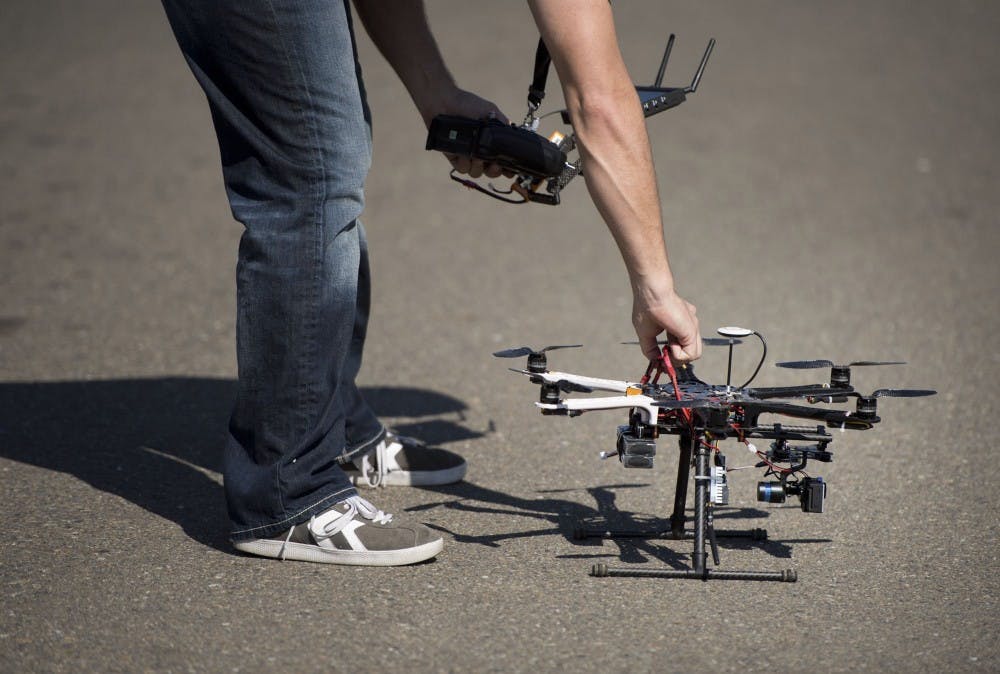The Consumer Technology Association said an estimated one million new drones could be flying by the end of the year, which will likely present challenges for aviation safety officials.
Amazon released details on its Prime Air drone delivery program in late November, and although the timeline is still unclear, the retailer says Prime Air will soon deliver packages up to 5 pounds in 30 minutes or less using small drones.
The program will start once government regulations are in place to support it. The FAA currently bans commercial drone flights except for a few dozen companies that have been granted waivers. Amazon has already been granted approval to fly drones for research.
Telecommunications instructor Tim Underhill, who has spent this semester teaching a class that focuses on the use of drones, said the rise in personal drone use is “inevitable” with the rise in availability, but new users should still be careful.
“Right now, you can go online and get [a drone] for under $1,000 — that’s a great deal for one of these things,” Underhill said. “But that doesn’t go without understanding the safety measure and guidelines that need to be followed when using this kind of technology.”
However, Underhill expressed concerns about new drone delivery programs, and he said safety might be compromised if companies like Amazon continue with projected plans.
“The parts on these drones are not always 100 percent durable — they do break,” he said. “Someone could be walking down the street and get hit — maybe hurt — by broken propellers or other parts. We’ll have to hope there are extensive safety measures put into place.”
Although toy-like drones may seem harmless, the Federal Aviation Association said all unmanned vehicles still have federal guidelines, and ignoring these rules can be extremely hazardous.
FAA rules already prohibit recreational drones from flying above 400 feet near airports or in other potentially dangerous areas. Now, the agency is working to implement new rules that would require hobbyists to register their drones before taking to the skies after the holiday season.
It’s not yet clear what will happen to drone users who don’t register with the agency. Penalties for failing to do so may exceed $25,000, according to FFA officials. But those high fines are aimed at people suspected of crimes like drug trafficking and tax evasion, and less strenuous punishments are more likely for hobbyists who ignorantly disobey the rules.
“Many of these new aviators may not even be aware that their activities in our airspace could be dangerous to other aircraft — or that they are, in fact, pilots once they start flying their unmanned aircraft,” said FAA Administrator Michael Huerta. “It’s crucial that owners of drones and other unmanned aircraft are aware of current and upcoming regulations, and safety awareness is going to be another key factor.”
But drones aren't always used for commercial retailers. Junior telecommunications major Jacob Logeman said his three years of experience flying drones has helped him become a better filmmaker.
“So far, I've mostly used my drone for aerial footage of Ball State University's campus,” Logeman said. “I think it's a great thing because it offers a new perspective for filmmakers while keeping costs low. I can only imagine how much it would cost to rent a helicopter or airplane to achieve the same shots I've already done with my drone.”
Even though Logeman has become experienced using drones for film, he’s also stayed up-to-date on FAA regulations and safety protocol.
“There are a lot of precautions to take when flying drones,” Logeman said. “One of the reasons why I haven't flown it on campus much since the summer is because of how many people are on campus now. It's not that I feel uncomfortable that I may crash — I've gotten decently confident when flying — but there is more of a risk when flying drones around people.”
For those purchasing and flying drones during the holiday season, The FAA won’t say whether the registration system will be in place before Christmas, or whether the final rules will mirror the task force’s recommendations.





